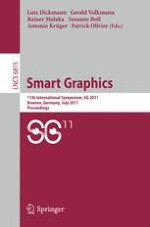2011 | Buch
Smart Graphics
11th International Symposium, SG 2011, Bremen, Germany, July 18-20, 2011. Proceedings
herausgegeben von: Lutz Dickmann, Gerald Volkmann, Rainer Malaka, Susanne Boll, Antonio Krüger, Patrick Olivier
Verlag: Springer Berlin Heidelberg
Buchreihe : Lecture Notes in Computer Science
